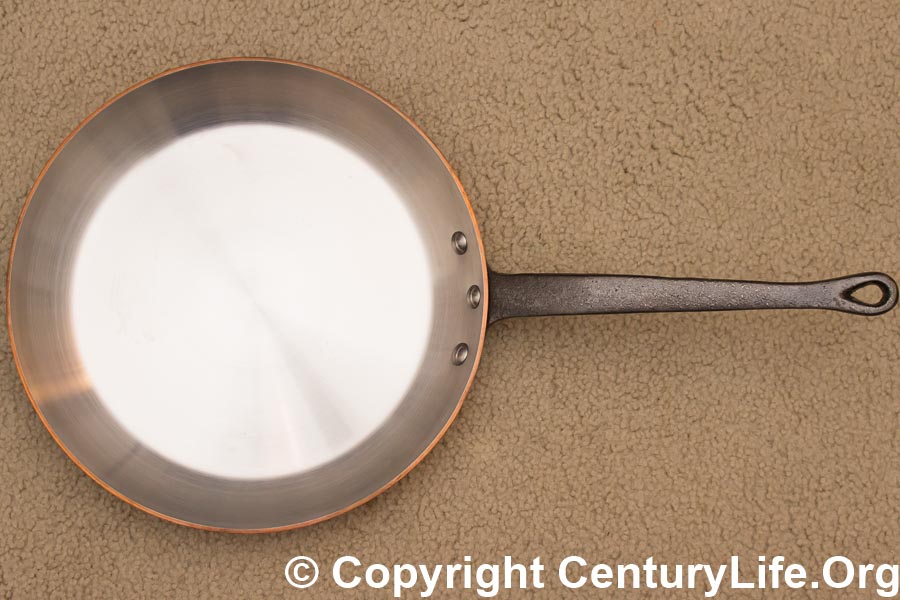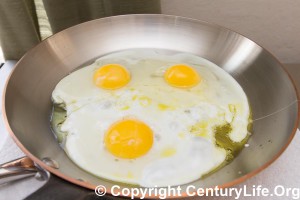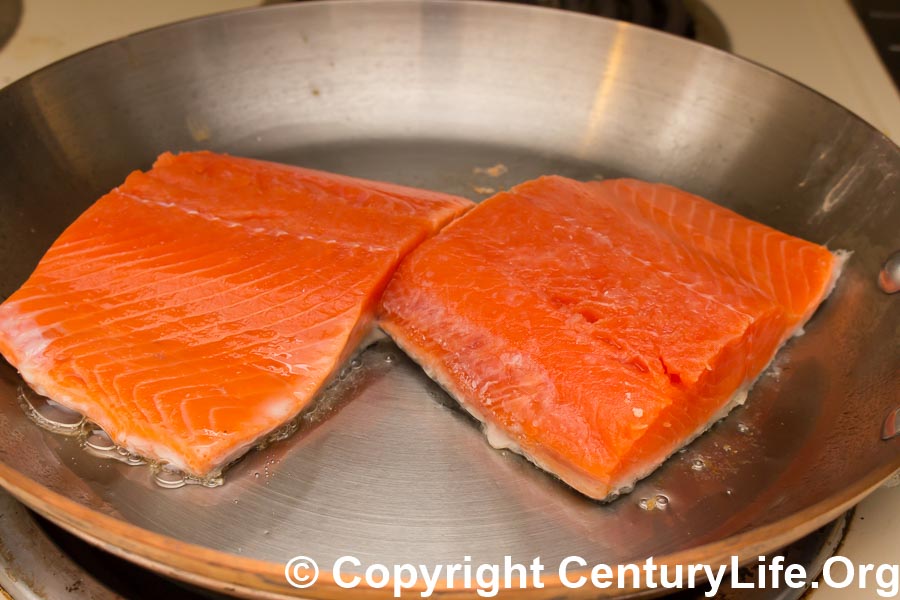
Note: If you have an induction stove, see De Buyer Prima Matera instead.
THE COMPANY
Mauviel (pronounced “moe-vee-ELL”) is an French company that has a ~200 year tradition of making fine cookware and is one of the oldest French cookware manufacturers still around.
In 1130, Henry I (King of England and Duke of Normandy) granted land in northwestern France to the Knights Hospitaller, who had returned from the Crusades.1 The Knights founded the village of Villedieu, translated literally as the “City of God,” from the words “ville” (city) and “Dieu” (God). The returning Crusaders had learned coppersmithing from their time spent in the Middle East, and by the 14th century, the local coppersmiths formed the Corporation of the Coppersmiths of Villedieu and were producing church ornaments, copper decorations, and cookware. By the 18th century, they also produced large church bells.
There are many cities called Villedieu in France, but this particular Villedieu, famed for its copper cookware, eventually became known as “Villedieu-les-Poêles,” or “City of God and Pans.” Residents are called “Sourdins,” from the French “sourd,” meaning “deaf,” supposedly because many copper artisans went deaf from hammering copper.
In 1830, at Villedieu-les-Poêles, Ernest Mauviel established the Mauviel manufacturing company to produce copper cookware for hotels and restaurants. Mauviel is still a family-owned, private business currently in the seventh generation of ownership.2 Mauviel is still a small company, employing just 80 people with revenues of 9 million euros as of 2010 (the most recent data available). Mauviel has increasingly marketed to home chefs: in the late 1990s, 80% of Mauviel’s revenues came from its commercial business, but that number has since dropped below 50%.3
THE PRODUCT
The subject of this review is the Mauviel 26cm (10.25 inch) copper frying pan (Mauviel M’Heritage Copper M250C, model 6504.26). However, this review is also applicable to the rest of Mauviel’s 2.5mm-thick copper cookware line. This product line used to be called “Cuprinox,” or “Professional,” but it’s now called “250c” or “M’Heritage 250c” or “M250c.”
Mauviel’s lineup of copper cookware is somewhat confusingly named, so here’s a short guide:
- 150c
= 1.5 mm total thickness: 0.2 mm stainless + 1.3 mm copper; cast iron handles. Such thin copper will heat up quickly but won’t retain heat that well, nor will it distribute heat that evenly. I don’t recommend getting such thin copper; either go thick or settle for aluminum. For instance, All-Clad MC2 heats slightly more evenly than 150c. (But 250c is much more even-heating than any stainless-aluminum clad out there, so there’s no aluminum-stainless substitute for thicker copper cookware.)
- 150s
and 150b
= same thing as 150c but with stainless steel handles and bronze handles, respectively. Stainless handles heat up more slowly. Bronze handles can’t rust but get hot like cast iron.
- 250c
= 2.5 mm total thickness: 0.2 mm stainless + 2.3 mm copper; cast iron handles. This is the thickest commercially-available (non-exotic) stainless-lined copper available. Responsiveness to changes in heat is superb. Heat retention is excellent. Evenness of heating is incredible. There is no 250b or 250s series, so if you want Mauviel’s finest copperware, it’s got to have cast iron handles, which is the traditional handle material of copper cookware.
In addition to copper cookware lined with stainless steel cooking surfaces, Mauviel also makes tinned copper cookware, which I don’t recommend to people unless they are fully aware of and accept its drawbacks:
- Pure tin is nontoxic and a little less sticky than stainless steel, and it’s the traditional way that copper cookware has been lined. (Bare copper reacts with a lot of foods, so generally speaking you need to coat a copper pan’s cooking surface with something less reactive/toxic. Historically that meant tin. However, it’s usually safe to make candy/jam in bare copper or use bare copper pans to fluff up egg whites, because those foods do not produce dangerous chemical reactions.)
- However, tin has several drawbacks: a) tin melts at ~450F which is uncomfortably low for those who like high-temperature frying/searing or who are worried that they or other household members might forgetfully overheat a pan; b) tin is soft, so even if you are careful to use only wood/plastic/silicone spatulas, things like bones in your food could still scratch and wear down the tin prematurely; and c) no matter how much you coddle a tinner pan, tin eventually wears off, requiring expensive re-tinning with pure, food-grade tin. Re-tinning can be quite costly if you factor in shipping back and forth. The total cost to re-tin a 10-inch frying pan is about $60 plus shipping.4
Regardless of lining, copper-bottom cookware does not work as well on induction stoves, losing efficiency and potentially overheating the induction stove. Therefore I don’t recommend copper-bottom cookware for induction.
Mauviel’s copper cookware has always been made in France, and it still is.
https://www.youtube.com/watch?v=yvOY1v4Cobc
RATINGS
Overall Rating: 3.95/5 Very Good. For an explanation of ratings methodology, click here.

Cleanup: 4/5 Very Good. I don’t give 5/5 scores to stainless steel pans, ever, because that’s reserved for Teflon-style pans. For a stainless steel pan, I’d rate this pan as average for stickiness. If you pre-heat the pan first, then add oil (or butter, etc.), and then turn down the burner and add food, then that should help reduce stickiness issues. Do not heat the oil along with the pan; it works better to add the oil only after the pan is hot.
I’m not going to take a point off for rivets, but it bears mentioning that exposed rivets can be harder to clean than flush-rivet or rivetless designs.
A nice side effect of copper is that it’s highly toxic to microbes. For instance, more than 99.9% of E. coli and MRSA bacteria die within 2 hours of contact with 99.9% pure copper. Even alloys with lower percentages of copper, such as brass and bronze, will kill microbes (albeit less efficiently).5 Copper even kills viruses and fungi. In comparison, such microbes can persist for weeks on stainless steel. But don’t read too much into this because the heat from cooking will heat up the pan to temperatures that instantly kill such microbes anyway.
Durability: 5/5 Excellent. Pans can warp when heated and cooled rapidly, such as by pouring cold water on them while they are still hot. Thicker pans can handle such abuse better (though you should not abuse your pans anyway). At 2.5 mm total thickness, 0.2 mm of which is rugged stainless steel, that’s a lot of heavy metal that should resist deformation well.
That said, copper is softer than stainless steel, so you will probably scratch up the bottom of the cookware over time. Copper also changes colors when exposed to heat, eventually turning a dull brown. Light scratches and an oxidized patina won’t affect cooking performance much, but if that bothers you, just polish the copper when your cookware develops too much patina for your tastes. Mauviel sells Mauviel M’plus Copperbrill Cleaner specifically for polishing its cookware.
To avoid handle rust, consider seasoning the handle with some Crisco, vegetable oil, or something similar. (Basically coat the handle with a very thin layer of oil and bake it at 400F+ for an hour, repeat a few times to build up a thicker coat if desired.) Wipe the handle dry after each use. Cast iron is somewhat brittle compared to steel, and with enough force you could break off the handle. So don’t bang the handle around a ceramic or steel sink. Dozens of generations of French chefs have successfully dealt with taking care of cast iron handles, so it’s not a huge problem, but it’s enough to warrant taking off a point.

Even heating: 5/5 Excellent. Given that this pan is a 26 cm pan and not a 28 or 30 cm pan, I won’t put the thermal results on the even heating rankings because it’d be unfairly comparing apples to oranges. (It’s bad enough that I have to list 28 and 30 cm pans together because many manufacturers make only 28 cm or only 30 cm pans–I’m not about to add 26 cm pans to the mix.) But suffice to say that 2.3 mm of copper + 0.2 mm of stainless would place this pan very near the top of the list. This pan not only heats very evenly, it also retains heat well. A thick, cold steak won’t crash the temperature of this pan as badly as it would with lesser pans. That means better browning, as you spend more time creating Maillard reactions and less time steaming the meat as you try to build the heat back up.
On Gas: What is remarkable about copper is how quickly it heats up and cools down when you turn the burner on or off, all while storing a good amount of heat. It only takes a little over a minute to get the pan up to a high enough temperature to fry eggs, on a 10,000 Btu flame. Such quick heating saves time and money in the form of lower utility bills. For comparison, an All-Clad Stainless pan takes closer to two minutes, and it does so at the cost of heating less evenly and retaining less heat.
On Electric: This pan has a flat bottom, which makes good contact with electric coil and smoothtop radiant electric stoves. But since electric stoves take a long time to heat up and cool down, using copper pans on such stoves will negate the ability of copper to change temperatures quickly. I would suggested lifting the pan up and putting it somewhere else, if you need to quickly cool down a pan on an electric stove.
Handling and ease of use: 3/5 Good. The handle is well-balanced, and the pan is in no danger of tipping even if it’s empty. But the handle is not that comfortable in part because it’s not very wide and can rotate against your wishes unless you brace it under your arm (which thankfully is easy to do). The pan also needs to be cared a little bit thanks to the cast iron handle which can rust if left wet. As I stated above, I recommend seasoning the handle with a bit of vegetable oil, Crisco, etc. Lastly, for shorter frying sessions (no more than about 8-12 minutes depending on your burner strength) the cast iron handle won’t heat up fast enough to hurt you, but longer frying sessions will heat up the handle to the point where you have to use protection. I always wrap a towel around cast iron handles so that I don’t have to play any guessing games as to whether the handle is too hot or not.
This pan could arguably use a helper handle, but it’s not absolutely necessary because you can brace the handle by tucking it under your arm. And if you have good wrist strength, you won’t need to do even that much. The 26 cm (10.24 inch) pan weighs 1960 grams (4.32 pounds) and has a flat cooking surface diameter of nearly 8 inches, which is about average for its size.
For reference, an empty All-Clad Stainless 30cm (12 inch) frying pan weighs 1265 grams (2.79 pounds) and has a flat cooking surface of about 9 inches, and the 30 cm (11.8 inch) version of this Mauviel M’Heritage Copper M250C pan (model number 6504.30) has a flat cooking surface of about 9 inches in diameter, as well.
M250c lacks flared rims for drip-free pouring, though if you’re careful it isn’t a big deal, and you can use a guide spoon, fork, or knife to guide liquid down into a container without it dribbling down the exterior of the pan.
Value: 3/5 Good. If you value thermal performance highly and can live with the handling drawbacks and lack of induction and dishwasher compatibility, then this pan is fairly priced. A lot of people also value the aesthetics/tradition/history of copper and cast iron handles. Copper oxidizes into a matte brown; some people don’t mind, and those who care should occasionally polish their copper cookware to restore its original shine (e.g., with Mauviel M’plus .15 liter Copperbrill Cleaner).
Versatility: 4/5 Very Good. Oven and broiler safe (to 500 degrees Fahrenheit). NOT dishwasher- or induction-compatible, though you can use an induction converter disc for shorter cooking sessions. If you have some firmly stuck-on bits, try boiling a little water in the pan to loosen stuck bits. If that doesn’t work, try using some Bar Keepers Friend.
The 26 cm diameter pan has a bottom flat circle of nearly 8 inches in diameter. That’s about average for a pan of that size.
https://www.youtube.com/watch?v=eIXqsCquv5o
CONCLUSION
Note: If you have an induction stove, see De Buyer Prima Matera instead.
If you highly value the ability of a pan to heat up quickly and yet retain enough heat so that it won’t crash in temperature like thin aluminum pans will when confronted with steak/fish/etc., or if you value pans that react almost instantly to changes in burner strength, then give this pan and the entire Mauviel M’Heritage M250c product line serious consideration. It’s not dishwasher-safe, but you shouldn’t be running good pans through a dishwasher in the first place. The pan is also not induction-compatible, but induction stoves make up only 7% of American stoves, so that’s not a problem for most people. The handles are about as (un)comfortable as All-Clad handles, if not worse since they get hot faster and can rust if you don’t season them, but if you brace the handle under your arm it should be fine. The handle is also well-balanced with the pan.
Even if copper weren’t the most bad-ass cookware material commonly used (only silver is more thermally conductive), there would be plenty of reasons to buy copper cookware. Stainless steel is great but has a clinical look, whereas copper looks warm and inviting by comparison. Many people utilize copper as part of kitchen decor, such as by hanging copper pots and pans for display on walls and racks. Copper cookware is rare and a conversation-starter when you bring home friends, family, etc. And worldwide, professional chefs and cooking enthusiasts have cooked in copper for about 10,000 years, from the ancient Egyptians to Julia Child. Top chefs have cooked in French copper for nearly 900 years, and Mauviel is among the oldest French cookware manufacturers (tied with de Buyer), having been established in 1830. So there’s a lot of cultural and historical association embedded in Mauviel’s copperware.
However, copper is not for everyone. For people who want copper-like performance with less maintenance, I would recommend Demeyere Proline and Demeyere Atlantis, which spread heat like 2 mm thick copper and are sheathed in rugged stainless steel. All that stainless means that Demeyere pans don’t react as swiftly to changes in burner strength, but that’s the price you pay for convenience.
If you can live with a bit of inconvenience, though (seasoning the handles to start out with, and either ignoring the copper patina or polishing your copper occasionally), these Mauviel M’Heritage M250c pans are among the best ever made.